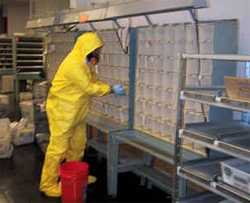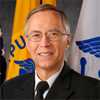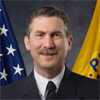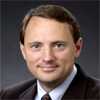CDC Responds to Anthrax - 2001
 Beginning in October, 2001, following the September 11 attacks in New York City and Washington DC, the United States suffered through another national scare brought on by multiple bioterrorism attacks using B. anthracis (anthrax) spores sent through the mail, resulting in several deaths and numerous exposures. CDC was at the forefront of the nation's response, working around the clock with state and local health officials to determine the source of the attacks, control the damage, and minimize the risk of exposure to the general public. Below are some of the stories of CDC doctors, laboratorians, and others who were on the front lines of that response ten years ago.
Beginning in October, 2001, following the September 11 attacks in New York City and Washington DC, the United States suffered through another national scare brought on by multiple bioterrorism attacks using B. anthracis (anthrax) spores sent through the mail, resulting in several deaths and numerous exposures. CDC was at the forefront of the nation's response, working around the clock with state and local health officials to determine the source of the attacks, control the damage, and minimize the risk of exposure to the general public. Below are some of the stories of CDC doctors, laboratorians, and others who were on the front lines of that response ten years ago.
Features
 Vision, Duty and Confidence Creates a No-miss Laboratory
Vision, Duty and Confidence Creates a No-miss Laboratory
Few stories cast the laboratory scientist in a leading role. However, laboratorians across the nation led in the response to the intentional release of anthrax through the mail in 2001. This crisscross of highly prized experts was trained to be able to detect anthrax in lab specimens, with uncompromising precision, by CDC's Tanja Popovic, M.D., Ph.D.
 Anthrax response in DC: Very Intense
Anthrax response in DC: Very Intense
Rima Khabbaz, M.D., led the CDC field team to the nation's capital during the public health response to the anthrax attacks of 2001. "I would characterize that time as very intense, we were acutely aware that we were dealing with an intentional attack, and focused on doing all we could to try and mitigate the consequences and save lives."
 "Please tell me, is it safe to go home?" After 9/11, science offers comfort
"Please tell me, is it safe to go home?" After 9/11, science offers comfort
The listening skills honed years earlier at a kitchen table on Long Island helped Rear Admiral Sven Rodenbeck, Sc.D., recognize the comfort his science could offer the people of Lower Manhattan following 9/11.
 From forest fires to terrorism: A champion for structure within chaos
From forest fires to terrorism: A champion for structure within chaos
Rear Admiral Scott Deitchman, M.D., M.P.H., actually is able to see the forest for the trees and has diligently championed more coordinated emergency response at CDC since his work with forest fighters in 1988.
 The learning never ends: Disease detectives follow every lead
The learning never ends: Disease detectives follow every lead
By the fall of 2001, Daniel Jernigan, M.D., M.P.H., knew his way around respiratory disease investigations. As a seasoned epidemiologist, with the CDC since 1994, Jernigan liked the hunt—who was getting ill, was there a cluster of cases, what relationship did patients have with each other, how long were they ill, when did symptoms begin, what was the attack rate?
 The real question was, “Will this hurt someone?”
The real question was, “Will this hurt someone?”
Not many people can bring up the risks from inhaling anthrax spores, microwave popcorn flavoring and nano particulates in the same conversation. CDC's Ann Hubbs, DVM, Ph.D., is that person. Hubbs was selected to respond to the 2001 intentional release of anthrax, in part, because she had a unique professional background.
 Interview with James M. Hughes, M.D.
Interview with James M. Hughes, M.D.
Read an interview with Dr. Jim Hughes, infectious disease expert and former director of CDC’s National Center for Infectious Disease.
- Page last reviewed: March 19, 2014
- Page last updated: March 19, 2014
- Content source:


 ShareCompartir
ShareCompartir